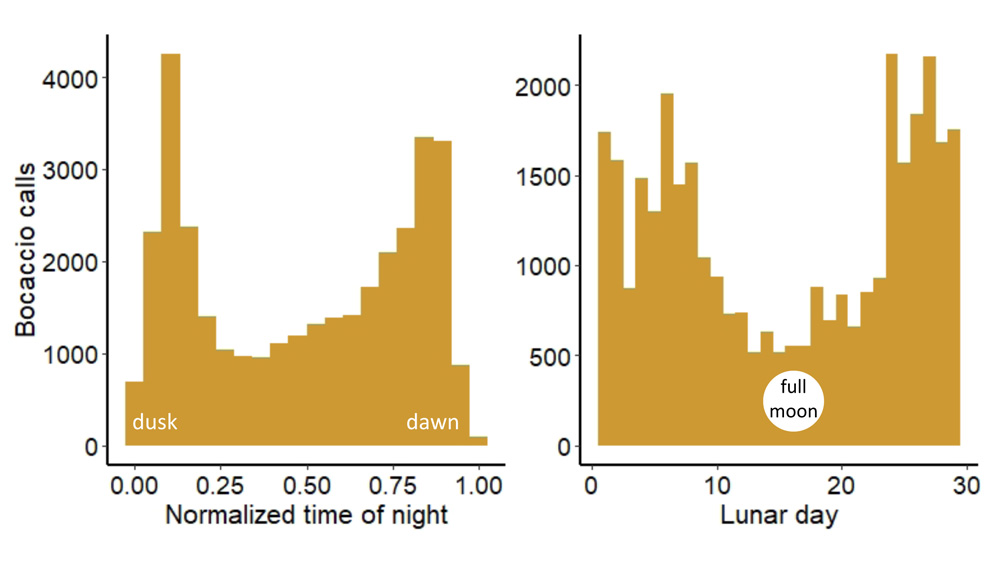One Fish, Two Fish, Quiet Fish, Loud Fish
By Lindsey Peavey Reeves
March 2021
Did you know that fish make sounds? They have sonic muscles – the fastest contracting muscles known in vertebrates – designed to move and vibrate the swim bladder (an air chamber in the abdomen of a fish). These rapid internal movements produce sound! The colder the water temperature, the slower the sonic muscles contract, which can lower the pitch of fish sounds, but not necessarily how often they produce sounds. Fascinating! But why do fish make sound, anyway?
Small, Mighty, and Loud!
Plainfin midshipman, a type of toadfish, can be found in shallow rocky reefs and the intertidal zone of Channel Islands National Marine Sanctuary during their breeding season. They have become adapted to breathing air when exposed at low tide, and can survive out of water for short periods of time. Photo: Björn S.
If I told you that you can hear the humming sounds produced by a fish no bigger than 15 inches long, while sitting high and dry beachside, would you believe it? It’s true! Plainfin midshipman (Porichthys notatus) are small (but mighty), are notoriously vocal, and very loud! Beachgoers tidepooling in Channel Islands National Marine Sanctuary might only hear them during certain times of the year, when they migrate from waters as deep as 1,200 feet to shallow coastal waters to breed during the spring through summer. SanctSound researchers were curious to learn where, when, how often, and how loudly the sounds of plainfin midshipman in the sanctuary could be heard. Since 2018 we’ve been listening in at five different locations of varying depths and habitat types. Midshipman were only recorded at two of the listening stations, and were heard most frequently and loudly at a shallow rocky reef on the north side of Santa Rosa Island, just west of Carrington Point.

One reason to eavesdrop on fishy conversations is to learn about their behavior. We started to hear midshipman in April 2019 at the start of their summer mating season, and their tonal calls consistently lasted all night long. Their low frequency calls don’t just blend in with the usual background noise – they are so loud that they dominate the soundscape. But these fish actually make different sounds depending on their sex and what they are doing: 1) large, vocal males excavating and protecting nests; 2) small not-so vocal males that attempt to “steal” existing nests; and 3) females. Large males dominate the nighttime chorus, humming for long periods of time to attract egg-bearing females. Those same males grunt and growl to protect their nests. The smaller and less vocal males are sometimes successful in taking advantage of the hard work done by larger, louder males by sneaking in to fertilize eggs. Both the small males and females produce brief grunting sounds when encountering another animal.

Listen to plainfin midshipman hum on the north side of Santa Rosa Island in Channel Islands National Marine Sanctuary.
After monitoring these tiny tuners for the past couple of years, a new research question arose: how sensitive are plainfin midshipman to noise interference while in shallow sanctuary waters? We pose this question because on a few occasions we observed that when a new sound enters their acoustic habitat, they go quiet. This suggests that while they can really belt it out when feeling secure, they might be sensitive to acoustic disturbance. These anecdotes require further study to better understand the dynamics at play, however it gives us motivation to continue studying these seasonal residents of the sanctuary.
Fish Lullabies
Bocaccio are slow-growing, late to mature, and long-lived Pacific rockfish found along the West Coast from the Gulf of Alaska to Baja California. Photo: Dave Murfin/NOAA
While plainfin midshipman are only present in the sanctuary during their mating season, bocaccio rockfish (Sebastes paucispinis) can be found throughout the sanctuary year-round. These fish make sound too, and their vocalizations are heavily influenced by sunlight and moonlight. There are actually many animals that coordinate their behaviors with the solar and/or lunar cycle, so bocaccio are not unique in that way. What we’ve observed in Channel Islands National Marine Sanctuary is that bocaccio have a strong preference for lullabies – we hear them calling mostly at night. We have consistently observed that their chorusing greatly reduces when the moon is full, and is highest when the moon is new.


Listen to bocaccio calls recorded in Channel Islands National Marine Sanctuary.
The ocean holds many mysteries, and we are still uncovering the natural history of a fish we encounter in the sanctuary regularly (bocaccio), and a fish we see seasonally (plainfin midshipman). Long-term passive acoustic monitoring is a low-cost, non-invasive, and round-the-clock research method we can continue to use to describe the life histories of fishes, without ever even laying eyes on them!
Lindsey Peavey Reeves, PhD, is the West Coast region Sanctuary Soundscape Monitoring Project coordinator at NOAA’s Office of National Marine Sanctuaries.
This story represents a study that was led by Dr. Annebelle Kok, a SanctSound analyst and a postdoctoral researcher at Scripps Institution of Oceanography.

